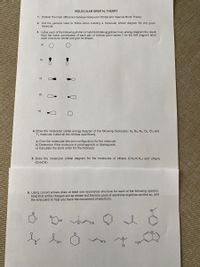
Chemistry
10th Edition
ISBN: 9781305957404
Author: Steven S. Zumdahl, Susan A. Zumdahl, Donald J. DeCoste
Publisher: Cengage Learning
expand_more
expand_more
format_list_bulleted
Question

Transcribed Image Text:MOLECULAR ORBITAL THEORY
1. Explain the main difference between Molecular Orbital and Valence Bond Theory.
2. List the general rules to follow when building a molecular orbital diagram for any given
molecule.
3. Label each of the following atomic or hybrid orbitals and draw in an energy diagram the result
from the linear combination of each pair of orbitals given below ? (In the MO diagram label
each molecular orbital and give its shape)
a)
b)
d)
e)
4. Draw the molecular orbital energy diagram of the following molecules: H2, B2, N2, O2, Cl2 and
F2 molecule. Label all the orbitals specifically.
a) Give the molecular electron configuration for the molecule.
b) Determine if the molecule is paramagnetic or diamagnetic
c) Calculate the bond order for the molecule
5. Draw the molecular orbital diagram for the molecules of ethene (CH₂=CH₂) and ethyne.
(CH=CH)
6. Using curved arrows draw at least one resonance structure for each of the following species.
, add
Note that all the charges are as shown but the lone pairs of electrons might be omitted s
the lone pairs to help you track the movement of electrons.
l lan
OH
NH₂
H₂N7
Br
Expert Solution
This question has been solved!
Explore an expertly crafted, step-by-step solution for a thorough understanding of key concepts.
Step by stepSolved in 2 steps

Knowledge Booster
Learn more about
Need a deep-dive on the concept behind this application? Look no further. Learn more about this topic, chemistry and related others by exploring similar questions and additional content below.Similar questions
- What is the hybridization of the N atom in this molecule? What are the hybridizations of the other 4 atoms indicated? ............................ H-G-C-ċ-ċ-ö-H H H :N-H 2 E→:ö: HHO: A Harrow_forwardWe have learned that the Lewis model portrays a chemical bond as the transfer or sharing of electrons represented as dots. Valence bond theory portrays a chemical bond as the overlap of two half-filled atomic orbitals. What is a chemical bond according to molecular orbital theory?arrow_forwardUse the References to access important values if needed for this question. A. What is the hybridization of the central atom in Bel,? Hybridization What are the approximate bond angles in this substance? Bond angles = B. What is the hybridization of the central atom in BF3? Hybridization What are the approximate bond angles in this substance? Bond angles =arrow_forward
- 7. The bond angels of NH3 have been experimentally determined to be 107°. According to valence bond theory, what are the expected bond angles? According to hybridization theory, what are the expected bond angles? If they are not the same, which model is the best match?arrow_forwardWhat is a property of diamond that can be explained using valence bond theory? It is sp2 hybridized through its structure. It is extremely hard. It conducts electricity readily. It exists in a trigonal pyramid shape. It is highly expensive.arrow_forwardWhat are the angles a and b in the actual molecule of which this is a Lewis structure? H H H C H a a = C b = ⁰ C H Note for advanced students: give the ideal angles, and don't worry about small differences from the ideal that might be caused by the fact that different electron groups may have slightly different sizes. H Xarrow_forward
- 2) a) Consider the following molecule . Given what you have learned about hybridization theory, draw an image or images explaining the bonding situation in this molecule. I want you to draw out all of the orbitals, hybrid orbitals and how they overlap to form the bonds in the molecule. Indicate the % s or p character in the given atomic and hybrid orbitals. Which C-C bond or bonds are the longest? In a paragraph or so explain the image or images you just drew. b) Lastly, consider the molecule below. Indicate the Molecular formula, the molar mass, label the hybridization of each atom except for hydrogen, indicate any chiral centers with a *, which bond or bonds are the shortest, identify by name of each functional group with an arrow pointing to the group.arrow_forwardI dont understand this. Determine the hybridization of the central atom in the compound PCl5.A. sp3dB. sp3C. sp3d2D. sp2arrow_forwardDetermine the covalent bonding of methane (CH4) using Valence Bond and Molecular Orbital models.arrow_forward
arrow_back_ios
arrow_forward_ios
Recommended textbooks for you
 ChemistryChemistryISBN:9781305957404Author:Steven S. Zumdahl, Susan A. Zumdahl, Donald J. DeCostePublisher:Cengage Learning
ChemistryChemistryISBN:9781305957404Author:Steven S. Zumdahl, Susan A. Zumdahl, Donald J. DeCostePublisher:Cengage Learning ChemistryChemistryISBN:9781259911156Author:Raymond Chang Dr., Jason Overby ProfessorPublisher:McGraw-Hill Education
ChemistryChemistryISBN:9781259911156Author:Raymond Chang Dr., Jason Overby ProfessorPublisher:McGraw-Hill Education Principles of Instrumental AnalysisChemistryISBN:9781305577213Author:Douglas A. Skoog, F. James Holler, Stanley R. CrouchPublisher:Cengage Learning
Principles of Instrumental AnalysisChemistryISBN:9781305577213Author:Douglas A. Skoog, F. James Holler, Stanley R. CrouchPublisher:Cengage Learning Organic ChemistryChemistryISBN:9780078021558Author:Janice Gorzynski Smith Dr.Publisher:McGraw-Hill Education
Organic ChemistryChemistryISBN:9780078021558Author:Janice Gorzynski Smith Dr.Publisher:McGraw-Hill Education Chemistry: Principles and ReactionsChemistryISBN:9781305079373Author:William L. Masterton, Cecile N. HurleyPublisher:Cengage Learning
Chemistry: Principles and ReactionsChemistryISBN:9781305079373Author:William L. Masterton, Cecile N. HurleyPublisher:Cengage Learning Elementary Principles of Chemical Processes, Bind...ChemistryISBN:9781118431221Author:Richard M. Felder, Ronald W. Rousseau, Lisa G. BullardPublisher:WILEY
Elementary Principles of Chemical Processes, Bind...ChemistryISBN:9781118431221Author:Richard M. Felder, Ronald W. Rousseau, Lisa G. BullardPublisher:WILEY

Chemistry
Chemistry
ISBN:9781305957404
Author:Steven S. Zumdahl, Susan A. Zumdahl, Donald J. DeCoste
Publisher:Cengage Learning

Chemistry
Chemistry
ISBN:9781259911156
Author:Raymond Chang Dr., Jason Overby Professor
Publisher:McGraw-Hill Education

Principles of Instrumental Analysis
Chemistry
ISBN:9781305577213
Author:Douglas A. Skoog, F. James Holler, Stanley R. Crouch
Publisher:Cengage Learning

Organic Chemistry
Chemistry
ISBN:9780078021558
Author:Janice Gorzynski Smith Dr.
Publisher:McGraw-Hill Education

Chemistry: Principles and Reactions
Chemistry
ISBN:9781305079373
Author:William L. Masterton, Cecile N. Hurley
Publisher:Cengage Learning

Elementary Principles of Chemical Processes, Bind...
Chemistry
ISBN:9781118431221
Author:Richard M. Felder, Ronald W. Rousseau, Lisa G. Bullard
Publisher:WILEY